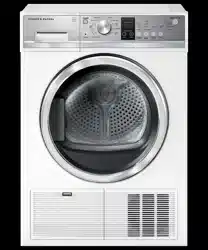Documents: Go to download!
User Manual
- User Manual - (English)
- Fisher & Paykel DE8060P2 8kg Condenser Dryer Specifications Sheet - (English)
- Installation instructions
- Getting started quickly
- Dryer control
- Sorting and loading
- Drying cycles
- Caring for your dryer
- Before you call for service
- Fault codes
- Troubleshooting
Table of contents
User Manual Condenser clothes dryer
Installation instructions
Installation options
Your dryer can be installed one of two ways, either freestanding, or stacked on top of a Fisher & Paykel front loading washer (specific models only).
1. Free standing
The dryer stands on the floor and can easily be moved into position.
2. Stacking
Your dryer has been designed to be able to be stacked on top of a Fisher & Paykel WashSmart™ or QuickSmart™ front loading washer (WH8560P, WH8060P and WH8560J models only). A stacking kit MUST BE USED between the products and fitted correctly to the washing machine.
- Stacking Kit White: Part No. 427976.
- Move the machine into the desired position. Do not lift the dryer by the top panel.
- Have a minimum clearance on all sides of at least 20 mm.
- Install the machine on a stable and level floor.
- Do not install your dryer in such a way that the dryer door cannot be opened fully.
- Do not install the dryer outside, in a damp place, where there is a risk of freezing, where it may be rained on, in direct sunlight or close to a source of heat.
- Do not place your machine on top of its power cable.
Levelling the machine
It is IMPORTANT to level the machine to ensure the machine runs efficiently with minimal noise. The dryer should be levelled in as close to its final position as possible so it stands balanced evenly on all four feet. Ensure the dryer does not rock in any direction.
The dryer comes with four adjustable feet, wind all four feet up or down until the dryer is correctly level. A spirit level can assist with this process. The machine is considered level when the bubble sits in the centre (ie within the two lines or the circle), when the spirit level is placed flat on top of your dryer, in the directions from:
- left to right
- back to front and
- corner to corner.
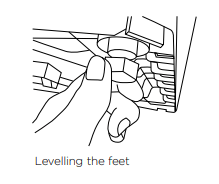
Never unscrew the feet completely from their housings.
Note: after levelling, the corners of the dryer cabinet should be clear of the floor and the machine must not rock in any direction.
Draining
The dryer is equipped with a condenser unit which accumulates water during the drying cycle. This water is collected in the removable water tank located at the top left of the dryer. The accumulated water must be emptied after each drying cycle. However you can also set up your dryer to drain automatically using the drain hose provided.

Connecting the drain hose:
- Remove the black drain hose from the connection at the back of the dryer A and place it on the other connection to the left B. Uncoil the white drain hose and connect it to the back of the dryer where the black drain hose was previously connected C.
- Place the other end of the white drain hose into a tub or standpipe. The connection between the dryer and the white drain hose C must be secured to avoid a potential flood.
Important! If you connect the white drain hose onto your dryer and you do not secure the other end in a drain, your dryer will drain water onto your floor. Ensure the drain hose is securely fixed in place to an appropriate drain and is leak-free at the connection to the machine.
- Regularly check that your standpipe or tub is free from lint and other obstructions, which may affect drainage and cause flooding.
- The drain hose should be checked from time to time and replaced if any damage, eg wear, cuts, bulges, kinks, leaks, etc are found. Do not bend the drain hose sharply, as this may cause it to split.
- The extended length of the provided drain hose is 1.3 m.
- In multi-storey apartments or any upper floor, the machine should be installed on a floor equipped with a drain.
- Draining must comply with local by-laws.
Electrical connection
- This appliance must be connected to a 220 V – 240 V, 50 Hz, sinusoidal, 10 A electrical supply.
- Uncoil the power cord, remove and discard the plastic pin cover and plug into a power socket.
- Connect the appliance to an earthed outlet protected by a fuse of suitable capacity.
- Check the power cord for damage and make sure it is not squashed or twisted when installing the dryer.
- Always remove the power cord from the power socket by the plug, not by the cord.
Important! If you are using an extension cord or a portable electrical outlet device (eg multisocket outlet box), ensure that it is positioned so that it does not come into contact with water or moisture. FAILURE TO DO SO MAY RESULT IN DEATH OR ELECTRICAL SHOCK.
- Do not touch or operate the machine with wet hands or with bare-feet.
- A damaged power cord must be replaced by a Fisher & Paykel Authorised Repairer, its service agent or similarly qualified persons in order to avoid a hazard. The appliance must not be operated until it is repaired, as there is risk of electric shock.
- Do not operate this machine if it has been damaged during transport. Contact your Fisher & Paykel dealer or Fisher & Paykel Authorised Repairer.
Completing the installation
Installation test cycle
Important! Ensure the installation test cycle is completed before you dry any items in your dryer. This is to check that your dryer is installed correctly and that it is functioning properly prior to use.
1. Turn your dryer on by pressing the  button.
button.
2. Select the ‘Time Dry’ 30 cycle. Ensure the drum is empty and the door is closed (you will hear it click shut).
3. Touch the  button. The drum will start rotating.
button. The drum will start rotating.
-
Observe the machine for any problems.
-
The dryer will beep and display any faults on the screen if there are any problems. Refer to pages 25 and 26.
4. At the completion of the cycle open the door and check that there is warmth inside the dryer. This indicates the dryer is operating normally
Important! If there are any problems, you must address these before proceeding with normal use. The dryer will automatically turn off at the end of the cycle if there are no problems.
Before you start, it is a good idea to go through the following checklist:
- Has the packaging been removed?
- Is the machine correctly levelled, and the cabinet corners clear of the floor and walls?
- Are the water tank, condenser and lint filter correctly in place?
- Has the power cord been connected to an appropriate power supply and the power turned on?
- Have you performed the installation test cycle?
- If external draining is preferred, is the white drain hose attached to the correct outlet and hooked into a standpipe or tub?
Machine specifications
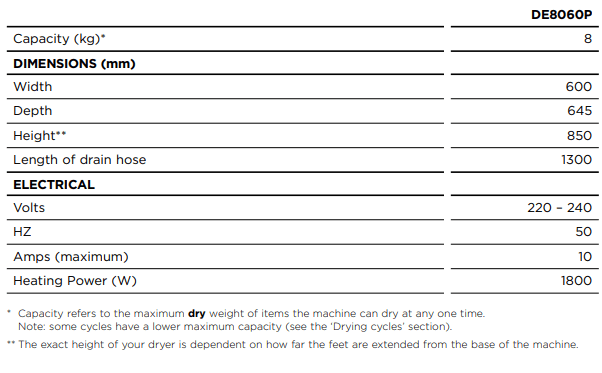
Getting started quickly
- Check the lint filter is clean and the water tank is empty before every load. Ensure both are replaced correctly before using your dryer.
- Sort and load items into the dryer drum, ensuring no items are in the way of the door. Close the door (you will hear it click shut).
- Press
 to activate your dryer.
to activate your dryer. - Your dryer will default to the ‘Everyday’ cycle. Select your desired drying cycle by turning the SmartTouch™ Control Dial.
- Select your preferred drying options, using the SmartTouch™ buttons on the right hand side of the panel (if you wish to select options different from the default options for the cycle).
- Touch the
 button to start the cycle.
button to start the cycle.
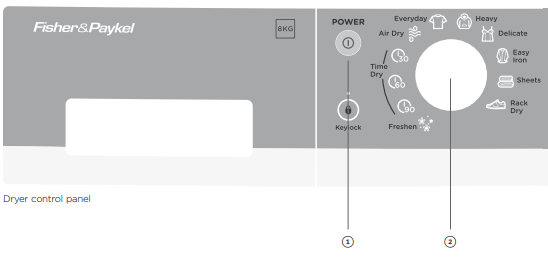
- If you make an invalid selection the dryer will beep to alert you.
- When the cycle finishes, your dryer will beep and then turn off automatically. If the ‘Wrinkle Free’ option has been selected the machine will rotate the drum periodically blowing cool air into the drum to help minimise wrinkling and creasing of your load.
- If you wish to stop your dryer at any point during a cycle simply touch
 to pause the cycle, then open the door.
to pause the cycle, then open the door. - If you wish to cancel a cycle or select a different option once a drying cycle has started, touch
 the button then select the new cycle or option. Touch
the button then select the new cycle or option. Touch  to restart the dryer with the new cycle and/or settings.
to restart the dryer with the new cycle and/or settings.
Important!
- If you wish to stop the dryer before the cycle has finished you MUST remove the clothes IMMEDIATELY and spread them out to cool. DO NOT leave the clothes in the dryer or bunched up in a clothes basket. Take extreme care as the drum and the load items may be extremely hot.
- Failure to follow the advice in this guide may result in damage to your garments and your expectations of drying performance may not be met.
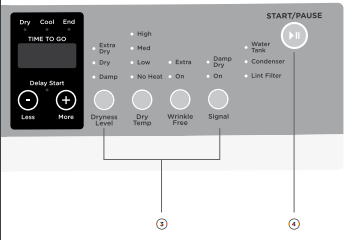
Dryer control
SmartTouch™ Control Dial
The SmartTouch™ Control Dial provides easy and efficient drying cycle selection. As you rotate the dial, the icon of the drying cycle selected will be illuminated, along with the default settings for that cycle on the right side of the control panel.
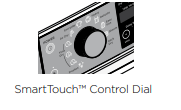
SmartTouch™ buttons
The smooth, easy clean buttons enable easy selection of options with lights clearly showing the selections you are making.

Digital display screen
The digital display screen provides feedback on how long the drying cycle has to go. If you have programmed a ‘Delay Start’, the time remaining until the cycle will start will be displayed here, along with any messages to help you with the overall running of your dryer (eg user warnings).
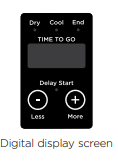
Time to go
Your dryer displays approximately how many minutes the cycle you are running has remaining if you have chosen one of the Time Dry cycles. If you have chosen an automatic cycle (ie not ‘Time Dry’) the word will appear on the screen until it reaches the cool down phase, at which time the dryer will display how long the cycle has left to go.
Please be aware that a number of factors can influence the overall cycle time, eg the fabric type of garments, load size, the wetness of the load, etc.

Progress lights
The progress lights indicate what part of the cycle the dryer is currently on (‘Dry’, ‘Cool’ or ‘End’). All three lights are on at the beginning of the cycle. The light for the current part of the cycle flashes, and each one goes out when that part of the cycle is complete.

Keylock
Keylock can be used to lock the buttons on your dryer. This will avoid accidental button pushes. For more detail please refer to the 'Drying cycle options' section.

Sorting and loading
When preparing your load there are some important things to consider:
Sorting
- It is best that you sort your garments before placing them into the dryer. Sort into loads of similar items, and loads that will take similar times to dry. Heavier items (eg towels, t-shirts and flannelette sheets) are best dried separately from lightweight items (eg synthetics, polyester-cotton sheets and shirts). This prevents the possibility of some items becoming over-dried whilst others are still damp. It will also help to extend the life of your clothing and linen.
- Look for a care label on your clothes as this will tell you if they can be safely tumble dried.
- Drying your clothes as soon as you remove them from the washer will decrease the chance of wrinkles, and dye transfer from coloured items to white items from occurring.
- We recommend that articles of clothing with screen-printing are turned inside out to prevent damage to the print. Garments with hooks or zippers should be fastened and where possible, turned inside out.
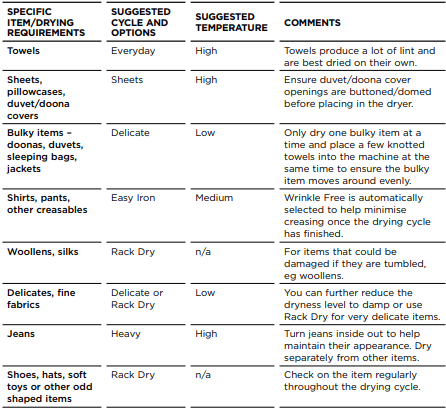
Before you load
- Check pockets for items that could damage your clothes or get caught in the dryer.
- Close zippers, hooks and eyes, and other fastenings (ie fasten the openings of duvet/ doona covers), and remove loose bra wires. These may damage both your dryer and your clothes.
- Check the lint filter is clean and the water tank is empty (if the dryer is not set up to automatically drain). Loading
- Garments need to be loaded correctly to minimise creasing and wrinkling, and to ensure the load is dried evenly. Make sure there is plenty of room for the garments to tumble freely while drying. Hint: load the dryer in terms of the space the garments take up when dry, rather than when they are wet. The general rule is that one wash load equals one dryer load. Do not overload your dryer, as it may damage your dryer and clothes.
- It is a good idea to dry 'permanent press' type garments (eg business shirts) together on a separate cycle with the ‘Wrinkle Free’ option on. This will help reduce wrinkling and the need for ironing.
To reduce tangling
- Load items individually.
- Dry sheets and duvet/doona covers on the 'Sheets' cycle. Ensure duvet/doona covers are fastened before placing in the dryer.
- Only dry bedding loads up to a maximum of 4 kg in the dryer.
- If you are experiencing a lot of tangling, try adding a dry, knotted towel to the load.
To reduce creasing
- Shake clothes out and load individually to help items dry evenly.
- Launder permanent press garments separately, eg business shirts.
- Allow enough room in the dryer for clothes to tumble freely.
- Hang garments as soon as the dryer cycle is complete to reduce the need for ironing.
Important!
- Do not overload your dryer beyond its rated capacity (eight kilograms of dry clothes).
- Never put dripping wet clothes in or on top of the dryer as excess water may cause an electrical hazard.
- Do not under any circumstances dry an electric blanket or any other electrical, plastic or rubber items in your dryer, unless the care label specifically states it is safe to do so. Never dry these items at high temperatures.
- Do not dry curtains in your dryer. Sunlight makes them brittle and they may disintegrate during drying.
Drying times
- Drying very small loads is inefficient. Try to dry medium to large loads.
- Heavier items (towels, T-shirts, flannelette sheets) will take longer to dry than light items (synthetics and polyester cotton sheets and shirts).
- Spin clothes at the highest spin speed suitable for the load type. The more water you remove in the wash, the less drying time required.
- Care labels on garments provide valuable information about the fabric type and how the garment should be dried. Always follow the advice on the garment labels. Only dry items in this dryer that have a care label stating tumble drying is suitable.
- Separate coloured items from white/light items where possible, especially when new. Colour run may be an issue, especially if you intend to delay the start of the drying cycle.
Lint
Some items are lint givers, while others are lint collectors. Always dry lint givers and collectors separately.

Delicate or easily damaged items (eg woollen or silk garments, nylon stockings, fine fabrics, delicate embroidered fabrics, garments with metal accessories, sleeping bags and other down items) should be dried separately, using the delicate cycle or the rack dry cycle (if you do not want them tumbled).
Drying rack
There are many items that would benefit from being dried on a drying rack. For example items like sport shoes, soft toys, hats and woollen items that may be damaged if they are tumbled.
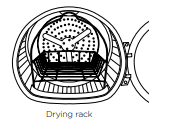
A drying rack is installed in your dryer when it leaves the factory. To remove it, tilt the top of the rack towards you to detach the legs from the slots in the lint filter, and gently remove from the drum.
When you are using the drying rack you must select the ‘Rack Dry’ cycle.
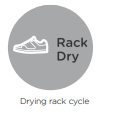
Drying cycles

Your dryer has a number of drying cycles to suit your laundry needs. Selecting the most appropriate cycle for each particular load will help ensure you get the best result.
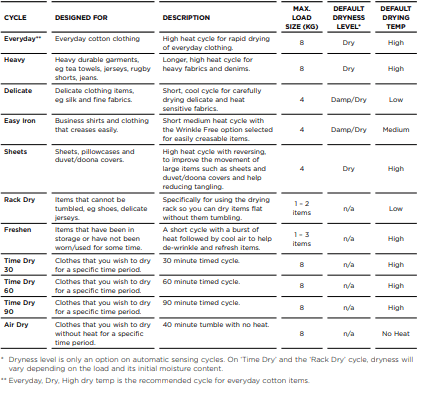
Timed programmes (Time Dry 30, 60, 90)
The machine dries for the selected time regardless of the level of moisture in your clothes. It is important to check the clothes throughout the timed programmes to avoid over drying.
All drying cycles default to the recommended options for that cycle based on the average expected load to be dried using that cycle. You can vary the options (eg ‘Dryness Level’, ‘Dry Temp’) to create your desired cycle. Note: some options are not available on some cycles, for clothes care reasons, or because the option is not appropriate for the cycle.
To change a drying option or options you have selected after a cycle has started, touch  and select your new setting, then touch
and select your new setting, then touch  again to resume the cycle with the new setting or settings.
again to resume the cycle with the new setting or settings.
Note: some options may not be available for selection under certain conditions and after particular stages of the drying cycle have passed.
Dryness Level
Your dryer takes the guess work out of choosing drying times by sensing the dryness of the load. When your dryer senses that the clothes have dried to the dryness level you have selected, the dryer will automatically finish the cycle.
The dryer has five dryness levels from Damp through to Extra Dry. Choose the dryness level to suit your load depending on how dry you wish for your clothes to be. If you find the load is not dry enough, select the next dryness level up. The higher the level, the longer the drying time and the drier your clothes will become.
Note: two lights are used to show some dryness levels. For example, to achieve the Damp Dry setting both the Dry and the Damp lights will be illuminated.

Airing/Cool down (Cool)
When the dryer has sensed that the load is dry it will automatically go into a 10 minute airing or cool down cycle. During ‘Cool’ the drum tumbles and cool air is blown through the clothes. This cools the load to reduce creasing if the clothes are left in the dryer.

Dry Temp
There are four drying temperatures you can choose from:
- High: Hot air up to 80°C is circulated through the clothes.
- Medium: Warm air limited to 70°C, is circulated through the load.
- Low: Uses warm air up to 60°C.
- No heat: Cool air is blown through the dryer for the period selected.
Touch the ‘Dry Temp’ button until the light next to your desired drying temperature is illuminated.

Wrinkle Free
If you wish to minimise wrinkling, select one of the ‘Wrinkle Free’ options. At the end of the cycle, the drum will rotate periodically and cool air will be circulated through the load to minimise wrinkling and creasing. This is particularly useful if you cannot remove the items immediately after the cycle ends. There are two wrinkle free options:
‘On’ provides ‘Wrinkle Free’ operation for 2 hours.
‘Extra’ provides ‘Wrinkle Free’ operation for 24 hours.
If you wish to stop the dryer at any stage during the ‘Wrinkle Free’ stage of the cycle, simply touch  . You can then open the dryer door and remove your items. Press
. You can then open the dryer door and remove your items. Press  to stop the cycle and turn the dryer off.
to stop the cycle and turn the dryer off.

Signal
The ‘Signal’ option automatically defaults to ‘On’ for all cycles. This means a series of beeps will sound at the end of a cycle, to alert you that the dryer has finished. You can turn the ‘Signal’ off by touching the ‘Signal’ button twice (no lights will then be illuminated).
When you select a dryness level above damp/dry and wish your dryer to alert you to remove items once your load reaches the damp/dry stage, touch the ‘Signal’ button once to select ‘Damp Dry’. Ensure ‘On’ is also selected. When your load reaches the damp/dry stage, the dryer will beep to alert you to remove your items, then continue drying until the remaining load reaches the dryness level you selected.

Indicators
There are a number of indicators to alert you when you need to attend to your dryer, either to clean the lint filter, empty the water tank or to clean the condenser (refer to pages 23 and 24 for more information).

Keylock
This option enables you to deactivate the buttons on the display panel, except for the  and
and  buttons. This option helps prevent accidental button presses.
buttons. This option helps prevent accidental button presses.
To turn Keylock mode ON or OFF, at any time when the dryer is powered on:
- Touch and hold the
 button for 2 seconds.
button for 2 seconds.
Note: when activated, the light above the  button is illuminated.
button is illuminated.
If Keylock mode is activated and the machine is powered off:
- To turn your dryer on, press the
 button, then touch and hold the
button, then touch and hold the  button for two seconds to turn Keylock off. Select your drying cycle, any options and then touch
button for two seconds to turn Keylock off. Select your drying cycle, any options and then touch  to start the cycle.
to start the cycle.
Delay Start
The ‘Delay Start’ option enables you to delay the start of the drying cycle from between 5 minutes and 12 hours. Times you can select are 5 min, 15 min, 30 min, 1 hour, then hourly up to 12 hours. This can be useful to time your drying to finish when you arrive home from work, or to start when power rates are lower.
To programme a ‘Delay Start’, simply touch the ‘More’  button to increase the delay time and ‘Less’
button to increase the delay time and ‘Less’  button to decrease the time or to turn ‘Delay Start’ off. Touch
button to decrease the time or to turn ‘Delay Start’ off. Touch  to confirm your selection and start the countdown. Once the ‘Delay Start’ has been started, the time will count down on the digital display in one minute increments, the ‘Delay Start’ light will flash and the
to confirm your selection and start the countdown. Once the ‘Delay Start’ has been started, the time will count down on the digital display in one minute increments, the ‘Delay Start’ light will flash and the  light will stop flashing and turn on solid.
light will stop flashing and turn on solid.
Note: if you hold the ‘More’  button down, the time displayed on the screen will increase after every half a second (more convenient than touching the button repetitively). To remove a delay start time once it is counting down, simply touch
button down, the time displayed on the screen will increase after every half a second (more convenient than touching the button repetitively). To remove a delay start time once it is counting down, simply touch  , then touch the ‘Less’
, then touch the ‘Less’  button to decrease the time to zero. Touch
button to decrease the time to zero. Touch  to start the cycle immediately.
to start the cycle immediately.
Important: We suggest that you avoid using ‘Delay Start’ for damp, non-colourfast items as this may cause dye run to occur.
Customising dryer cycles
After using your dryer a few times you may discover there are some drying options you prefer for some cycles.
You can programme your dryer to remember the drying options you prefer for each drying cycle. For instance, you may want to set the ‘Easy Iron’ cycle to a lower drying temperature or set the ‘Everyday’ cycle so it automatically has the ‘Wrinkle Free’ option selected.
To customise a cycle:
- Press
 to turn the machine on.
to turn the machine on. - Turn the dial to select the cycle you wish to customise.
- Touch and hold any of the drying options buttons for 3 seconds. The lights will flash on and off to indicate that the machine is in cycle adjustment mode.
- Select the drying options you prefer by touching the relevant option button.
- Touch
 to save the selected settings. The dryer will then beep to indicate your customised cycle has been saved.
to save the selected settings. The dryer will then beep to indicate your customised cycle has been saved.
Factory reset
You can reset your dryer to the default settings it left the factory with:
- Turn the dial to select the ‘Freshen’ cycle.
- Touch and hold the ‘Delay Start’, ‘More’
 , the ‘Delay Start’, ‘Less’
, the ‘Delay Start’, ‘Less’  and ‘Signal’ buttons together for three seconds.
and ‘Signal’ buttons together for three seconds. - Your dryer will now be reset to the default settings.
Caring for your dryer
When you have finished using your dryer
- Unplug the machine from the power socket.
- Wipe around the door to remove any remaining condensation and foreign matter.
- Clear the lint filter and empty the water tank (if not set up to automatically drain).
Cleaning your dryer
Before you start cleaning your dryer, ensure that it is disconnected from the power (ie unplug the machine from the power socket).
Cleaning the control panel and outer surfaces of the dryer
Use a soft damp cloth to wipe all surfaces, then wipe dry. Avoid using chemical or scouring cleaners, as these will damage the paint and plastic surfaces of your dryer.
Cleaning the inside of your dryer
It is important that you occasionally clean the inside of your dryer. If the drum has any residual dirt or lint stuck to it, remove this and wipe it clean with a damp cloth. Do not leave any metal objects in the drum, as these may cause rust.
Cleaning the lint filter
- Lint is generally formed during wearing and washing. Fibres (ie lint) released from the clothes during the drying cycle are collected in the lint filter.
- It is important to clean the lint filter after every load, as the lint produced in the drying process can become a fire hazard if it is allowed to accumulate in or around your dryer.
- The lint filter is located in the door opening (at the bottom).
- There is a warning light that will flash at the beginning of every cycle to remind you to clean the filter and will stop once the
 button is touched. The warning light will also flash on and off during the cycle if the filter becomes blocked. The filter should be cleaned as soon as the ‘Lint Filter’ light starts flashing. Lint becomes a fire hazard if left to build up, and will reduce the efficiency of your dryer.
button is touched. The warning light will also flash on and off during the cycle if the filter becomes blocked. The filter should be cleaned as soon as the ‘Lint Filter’ light starts flashing. Lint becomes a fire hazard if left to build up, and will reduce the efficiency of your dryer.
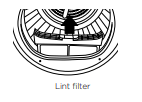
To clean the filter:
- Open the dryer door.
- Remove the lint filter by pulling it up and out of the filter slot. Open it out and wipe the surface clean with your hand.
- Close the lint filter and place it back in the opening. Ensure the filter is fitted correctly back in place before operating the dryer.
Important : If the lint filter becomes damaged, contact your Fisher & Paykel Authorised Repairer to arrange getting a new filter. Do not operate your dryer with a damaged lint filter or without the filter in place, as this will cause damage to your dryer.
Emptying the water collection tank:
During the drying cycle steam condenses into water and is collected in the water tank, located at the top left of the dryer. It is important to empty the water tank after every load.
There is an indicator light that will illuminate when the water tank needs emptying. A user warning will also be displayed on the screen (refer to the 'Before you call for service' section). If the water tank becomes full during operation, the dryer will go into ‘Cool’ mode for several minutes, then pause and beep to alert you. Empty the tank and touch  to resume the cycle.
to resume the cycle.
Note: you do not need to empty the water tank if you have set up the drain hose to drain the water automatically

To empty the water tank:
- Remove the water tank by holding onto the handle and pulling outwards gently to remove it. Ensure that you keep the tank level when it is being removed to prevent the water collected from spilling.
- Pour the water down the sink or into a bucket, and then put the tank back in place.
Important:
- Do not use the water collected in the water tank for drinking or food processing.
- Never run the dryer without the water tank in place.
- If the water tank becomes full, the tumble dryer will pause drying and will sound an alarm. You must empty the water tank before the dryer can continue drying. Empty the tank, replace it back in the housing then touch
 to resume the cycle.
to resume the cycle.
Cleaning the condenser:
If the ‘Condenser’ indicator light starts to flash this indicates that the condenser needs to be cleaned. The condenser should be cleaned after every 100 drying hours. The light illuminates when you first turn the machine on, then turns off once the  button has been touched.
button has been touched.

To clean the condenser:
- Switch off the power supply and remove the power plug before cleaning the condenser.
- Open the condenser cover.
- Turn the two condenser lock levers 90 degrees then pull out the condenser.
- Clean the condenser with pressurised water and wait until the water drains.
- Replace the condenser.
- Turn the two condenser lock levers to lock the condenser back in place again. Make sure that these locks are engaged securely.
- Close the condenser cover.
Cleaning the sensors:
There are humidity sensors in your machine that detect whether the laundry is dry or not. These sensors need to be cleaned periodically (we recommend approximately four times a year).

To clean the sensors:
- Open the door of your machine.
- Allow the machine to cool if drying has been carried out.
- Locate the metal sensors just behind the lint filter.
- Wipe the sensors with a soft cloth, dampened with vinegar. Dry the sensors with a dry cloth.
Before you call for service
User warnings
Your dryer is capable of diagnosing a number of its own problems. It will sound a continuous series of beeps and display a code when it has a problem that you can correct yourself. All control panel lights will turn off and a code will be displayed to inform you what the problem is. To stop the beeps sounding, press any button on the control panel. Do not try to continue your drying cycle once you stop the noise. You must address the problem the dryer is alerting you to.
Check this chart before you call for service :
The lint filter is blocked and needs to be emptied 
- Empty the lint filter and then replace it.
- Check the lint filter is not damaged.
- Check there is nothing else stuck in the lint filter holder which may be blocking the air flow.
- Check the lint filter is in place correctly in your dryer
The water tank is full and needs to be emptied 
- Check if the water tank is full.
- Empty the water tank.
- If using the drain hose, check whether the water tank or drain hose is blocked.
- Check the drain hose is still attached at the back of the machine, and is not kinked or squashed.
The condenser needs to be cleaned 
- Clean the condenser (refer to the ‘Caring for your dryer’ section). Ensure the condenser unit has been placed or replaced correctly into your dryer.
The door is not closed 
- Close the door fully and touch

- Try opening and closing the door again.
- Reposition the load, make sure the load is correctly in the drum and that protruding items are not stopping the door from closing
Once you have addressed the issue the user warning was alerting you to, try using your dryer as per usual.
If the symptom persists, call your Fisher & Paykel Authorised Repairer.
Fault codes
When a continuous series of beeps is sounded, all the lights turn off on the control panel and a number appears on the display, a fault has occurred. The dryer will automatically enter this mode if a fault occurs. The fault code will be displayed as followed by a number on the digital display. To stop the beeps, touch any button then perform the following steps:
- Turn your machine off at the power point.
- Wait one minute and turn it back on.
- Check your machine is installed correctly (refer to the ‘Installation instructions’ section).
- Remove your dryer load and retry.
- Perform a ‘Time Dry’ cycle, eg Time Dry 30.
- If the fault re-occurs repeat steps 1 and 2.
- If the machine still will not work you will be required to call a Fisher & Paykel Authorised Repairer to arrange service (refer to the ‘Customer Care’ section). Record the fault code number displayed and the serial number of your dryer (located on the rear of the machine, or on the inside of the door below the glass) before calling. The fault code will indicate to the Repairer what the problem could potentially be.
If a fault code is being displayed, you can still turn your dryer off by pressing  .
.
Troubleshooting
The following is a list of problems you may encounter when using this appliance and some suggestions that may help to correct the problem. If you still have problems, please contact your Fisher & Paykel Authorised Repairer.
Pressing  does not turn on the dryer.
does not turn on the dryer.
- Electrical cord not plugged into a power socket.
- Plug cord into a power socket.
- Power switch not switched on.
- Switch power on.
- Fault with household power supply.
- Try plugging another electrical appliance into the same socket. Turn off the power at the power point. Unplug the dryer from the power socket. Wait 60 seconds, plug it back in, turn it on and try again.
Dryer does not heat.
- Dryer set to ‘Air Dry’ cycle.
- Check what cycle the dryer is set to (refer to page 18). Change to preferred cycle.
- Full water tank.
- Empty the water tank (refer to page 23).
- The dryer has progressed to ‘Cool’.
- Check the progress lights – are the ‘Cool’ and ‘End’ lights illuminated? Refer to page 19.
Touching  does not start the drying cycle.
does not start the drying cycle.
 not touched firmly enough.
not touched firmly enough.
- Touch
 again.
again.
- Touch
- Dryer is paused.
 light will be flashing. Touch
light will be flashing. Touch  to resume the cycle.
to resume the cycle.
- Dryer door not closed properly.
- Open and reclose the door.
- Is the dryer displaying a user warning or fault code?
- Refer to pages 25 and 26.
- Water tank full or not properly in place.
- Empty the water tank (refer to page 23). Ensure the water tank is properly in place.
- Lint filter needs to be emptied.
- Empty the lint filter and ensure it is correctly in place.
- Dryer is overloaded.
- Remove some items from the dryer.
- Delay Start’ function is set.
- Refer to page 21 for more information.
Dryer keeps stopping and starting.
- The ‘Wrinkle Free’ option has been selected.
- Refer to page 20 for more information.
Dryer stops working midcycle.
- Power failure.
- Press
 and restart the desired cycle.
and restart the desired cycle.
- Press
- Dryer has been paused.
- Touch the
 button to restart the cycle.
button to restart the cycle.
- Touch the
- Dryer door is open.
- Ensure the door is firmly shut.
Dryer is taking too long/ results were not satisfactory.
- Drying cycle selected not appropriate for the load.
- Select an appropriate cycle for the load. Refer to pages 15 and 18
- Dryness level selected not appropriate for the load.
- Select a higher dryness level. Refer to page 19.
- Selected drying temp, not appropriate for the load.
- Select a higher drying temp. Refer to page 19.
- Dryer overloaded for the cycle.
- Some cycles have a lower max load size. Refer to page 18.
- Try dividing the load in half and dry half at a time.
- Lint filter is blocked.
- Clean the lint filter.
- Condenser is blocked.
- Clean the condenser. Refer to page 23.
- Water tank is full.
- Empty the water tank. Refer to page 23.
- Environmental conditions may be affecting dryer operation.
- In hot, humid conditions the dryer will take longer to dry a load and be less efficient
- Load overly wet at the start of cycle.
- Remove more water from the load before placing it in the dryer, eg select a faster spin speed on your washer, if appropriate for your load.
- Dryer not draining water out properly.
- Check the drain hose (if connected) for blockages or damage. You may need to call for service (refer to page 35).
- Items got wrapped up inside other items.
- Try separating items and drying similar items together. Open items out when you place them in the dryer. Do not fold them up. Untangle items, eg pull long sleeves out so they are not stuck/trapped on the inside of the garment.
Dryer is not draining.
- Drain hose not connected to the water tank.
- Ensure the drain hose is connected correctly (refer to page 8).
- Water tank not in place correctly.
- Ensure water tank is properly in place.
- Drain hose or drain blocked or damaged.
- Check drain hose (if connected) and drain for blockages or damage.
Clothes getting too hot or damaged.
- Cycle selected not appropriated for the load.
- Ensure the cycle selected is appropriate for items in the load. Refer to pages 15 and 18.
- Items removed from dryer before the end of cycle cool down had finished.
- Removing items before cool down may damage clothing if it is not spread out and exposed to air to cool once removed from the dryer.
Dryer is beeping, displaying unfamiliar light patterns and/ or a message on the digital display
- Dryer is experiencing a fault.
- Try turning the dryer off and waiting 30 seconds before turning it back on. Refer to pages 25 and 26.
Small puddle of water coming from under the machine.
- Water tank not correctly in place.
- Ensure the water tank is correctly in place.
- Water tank may need to be emptied.
- Empty the water tank.
- Water tank may be damaged.
- Check the water tank for any signs of damage.
- Drain hose may not be attached properly at the machine end.
- Ensure the drain hose is attached properly. Refer to page 8.
- Drain hose could be damaged.
- Check the drain hose for damage.
- Drain hose has slipped out of the drain.
- Ensure the drain hose is securely fixed in place. Sometimes drain hoses can move or get displaced, which may lead to water draining onto the floor.
- Drain may be blocked.
- Check the drain for any blockages.
- Dryer door not closing properly, affecting the seal.
- Ensure the dryer door is closed properly and there is nothing obstructing the door opening.
Cycle time longer than usual.
- Cycle time may be affected by a number of factors and is approximate.
- Cycle time is affected by the size and composition of the load, how wet/dry the load was to begin with, the environmental conditions the dryer is operating in, cycle options selected, sensing while drying and any interruptions during the cycle. Refer to page 14.
Small amount of water in the drum at end of cycle.
- Water tank needs to be emptied.
- Empty the water tank.
- Environmental conditions may be affecting dryer operation.
- If conditions are particularly hot and humid, it is possible vaporised water may re-condense in the drum or on the inside of the door
Noises.
- Dryer is overloaded.
- Remove some items from the dryer
- Dryer is experiencing a fault.
- Continuous beeping or a musical series of beeps with a message displayed on digital display. Refer to pages 25 and 26.
- Beeps signalling the end of a drying cycle.
- End of cycle beeps can be turned off (refer to page 20).
Vibration.
- Dryer is not installed on a stable surface.
- Ensure the dryer is installed on a flat, stable surface. Refer page 6.
- Dryer is not level.
- Ensure the dryer is correctly levelled. Refer page 7.
- Dryer is overloaded.
- Remove some items from the dryer
Creasing.
- Cycle selection not appropriate for the load.
- Select the ‘Easy Iron’ cycle to minimise creasing.
- Dryer is overloaded.
- Remove some items from the dryer.
- ‘Dry Temp’ and/or ‘Dryness Level’ selected too hot/too long for load type.
- Try selecting a lower ‘Dry Temp’ and ‘Dryness Level’.
- Wrinkle Free’ option not selected.
- Select the ‘Wrinkle Free’ option to rotate the load at the end of the drying cycle. Refer to page 20
- Wet items left sitting in the dryer for a long period before starting the cycle.
- Try not to leave wet items sitting in the dryer for long periods.
Linting.
- Lint filter not cleaned or replaced.
- Ensure the lint filter is cleaned after every cycle and replaced correctly. Refer to page 22.
- Dryer is overloaded.
- Remove some items from the dryer
- Loads not sorted correctly.
- Dry lint givers separately from lint receivers. Refer to page 17. Also, dry similar colours together eg light coloured items with light coloured items, dark items with dark items. Refer to page 17.
- Clothes over dried.
- Over drying clothes in the dryer can cause them to attract lint. Use an auto sensing cycle or ensure you check your load if using the time dry cycles to avoid over drying. Refer page 18.
- New items have been dried in the dryer recently.
- New towels or flannelette sheets can leave lint in the dryer, which may be picked up by subsequent loads.
Fabric damage.
- Delicate items not dried on an appropriate cycle.
- Dry delicate items on ‘Delicate’ or ‘Rack Dry’ cycles. Refer pages 15 and 18
- Metal parts on the items or in the load.
- Fasten zips and other clasps before placing items in the dryer.
- Items not separated or dried on an appropriate cycle for the fabric type.
- Dry similar items together. Ensure an appropriate cycle is selected. Refer to pages 15 and 18.
- Items fell off the rack when using ‘Rack Dry’.
- Ensure the rack is installed correctly (refer to page 17) and only one or two garments are placed on the rack at a time.
- ‘Dry Temp’ or ‘Dryness Level’ selected not appropriate for the fabric type.
- Ensure the ‘Dry Temp’ and ‘Dryness Level’ selected is appropriate for the fabric type. Refer to the items care label. Refer to page 19.
- Used a ‘Time Dry’ cycle and did not monitor the dryness of clothes during the cycle.
- Ensure that clothes are checked for dryness during the cycle when using the timed programmes to avoid over drying. Refer to page 18.
- Instructions on care label not followed.
- Follow the instructions on the care label of the items.
Dye transfer.
- White/ light and coloured items not separated before drying.
- Remember to separate white/light and coloured items before placing them in the dryer.
- Wet items left sitting in the dryer for long periods of time before drying.
- Do not leave wet items sitting in the dryer for long periods of time before drying, if they may be prone to colour run. If you do intend to leave them for long periods before drying, then separate the load and put those items that may cause colour run aside.
Tangling
- Loads not separated.
- Try separating out larger items from smaller items.
- Items loaded into the dryer incorrectly.
- Load items individually into the dryer. Do not place folded items in the dryer.
- Incorrect cycle selection.
- Try using the ‘Easy Iron’ cycle to dry shirts and the ‘Sheets’ cycle to dry sheets. Refer to pages 15 and 18.
- Load size too large. T
- ry drying smaller load sizes. Some cycles have a lower maximum load size. Refer to page 18.
- Delicate items not dried on ‘Rack Dry’.
- Dry pantyhose, bras and any other delicate items prone to tangling on the ‘Rack Dry’ cycle.
- Sheets and duvet covers due to their size, are prone to tangling.
- Dry sheets and duvet/doona covers separately from other laundry, apart from towels. Ensure duvet/doona covers are buttoned or domed closed before drying. Try adding a knotted towel to sheets loads if you are experiencing a lot of tangling.
See other models: E450LXFD1 CI905DTB1 CG302DNGGB1 RF411TRPW6 RF411TRPX6
